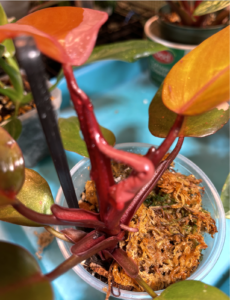Propagating plants is very rewarding. What’s better than making more plants from your mother plant? But it can be frustrating when you put a cutting of your prized plant in water and it rots. It may sound silly but it’s a good idea to test your propagation skills on an unimportant plant before you cut your prized plant.
Propogation is the process of taking a cutting of the plant and causing it to grow roots. Water and air are required for the process. Light is sometimes important. Humidity and temperature will help speed the process. There are also hormones that can accelerate rooting.
There are a number of mediums for propagating. They range from water, moss, leca, perlite to propagating machines. Some types work better for certain plants. We all want the shortest time to roots so you may want to consider the options available. I will talk about using the following for propagating: water, moss, leca and perlite.
- Water: Some plants will easily grow roots in water. The downside to water is that some plants need a mix of air to grow roots. Instead of rooting in water, they decompose (commonly called rotting and it’s a sad scene!). The best plants have some stems such as Hoya Bella, tradescantia and many philodendrons.
- Planting medium: like soil, coco coir (coconut hulls shredded), etc. I started rooting Hoyas in soil and a plastic bag. It worked most of the time but once I started using leca I didn’t go back.
- Moss: Many people have propagation boxes set up with a layer of moss in it and they put their cuttings in a loose manner. I use moss for specific plants and keep the cuttings in separate containers. I use moss for plants with woodier stems like monstera peru and many use it for scindapsus, standleyana, etc. Some use moss for everything.
- Leca: LECA is an abbreviation for Lightweight Expanded Clay Aggregate. These clay pebbles are frequently used in hydroponics (water plant culture) and it’s a great option because air is mixed in with the water on the stem of the cutting. I use leca for Hoya, philodendrons and most everything including scindapsus.
- Large perlite: This is used like leca and also allows the air to circulate around the cutting but the perlite is able to make more contact with the stem. I recently started using this and am now preferring it over leca in some cases because it touches the stem in more places. And the tricky plants like standleyana’s and scindapsus respond to it best.
After all that, the best method depends on what you prefer and the plant that you are propagating. You can be successful with a simple set up on your kitchen counter with vials of water holding your cuttings. If you have a number of cuttings you may want to get a clear plastic prop box and a few other pieces of equipment.
That’s an overview of the options. I will link to specific information about using each medium and the equipment I use.








